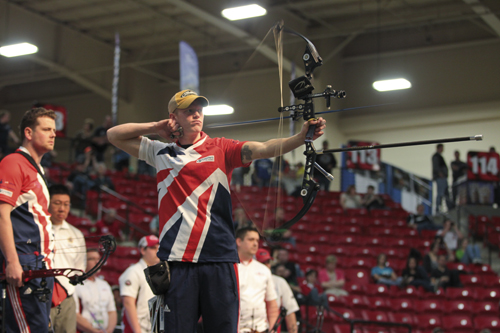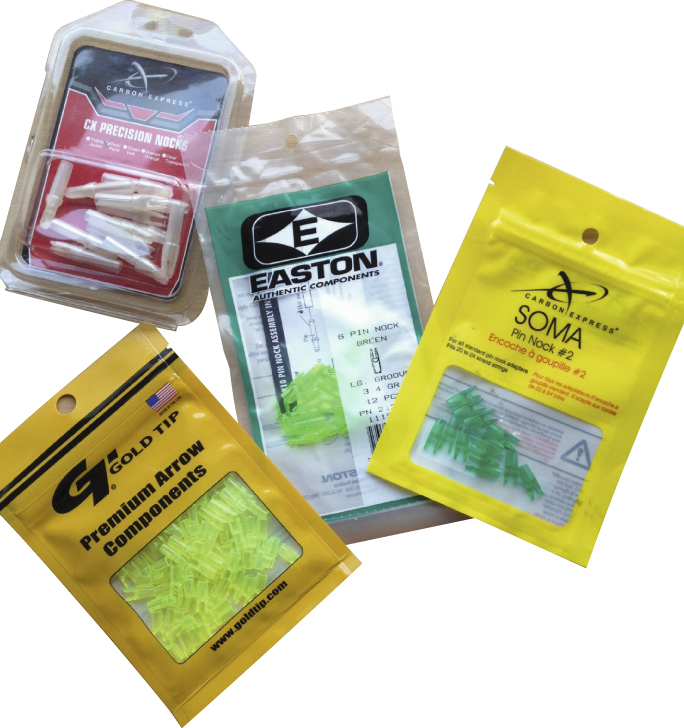Liam Grimwood explains how your choice of nock can have a bigger effect on your scores than you might think
Choosing a good nock for your arrows is something many archers overlook. Archers pour hours of their time into choosing the right bow and arrow combination, and making sure the tune and fl ight is just right, but many of us – myself included – just get some nocks, push them on, and forget about them. The nock, although only a few grains of plastic, is the all-important link between the string and your arrow, and this article aims to tell you why it shouldn’t be overlooked.
Firstly, it’s important to pick the right nock, and there are a number of options out there. Most of these options will use the pin system. This is a metal pin that sticks in the back of the shaft and allows a pin nock to fit on. This pin system has standardised nocks and allows one size of nock to fi t onto any spine of arrow. The pin system, whether you shoot Carbon Express, Easton or Gold Tip arrows is, in my opinion, definitely the way to go. Having the metal pin in the back of the arrow ensures an exact machine tolerance fit in the back of the shaft, and it also gives the plastic of the nock a form to hold to. I also believe the pin system can help prevent the back of the arrow from cracking a lot of the time, as if it gets hit by another arrow when in the target it simply dints the pin and leaves the arrow intact. Finally, the pin system stops pieces of plastic getting stuck in the shaft if you do have an impact, as the metal pin is easily removed. One-piece plastic nocks can snap and lodge themselves inside the shafts, which can be time consuming and fiddly to repair.
So once you have your pins fitted in your arrow, what nock should you go for? I put four leading nocks on trial for this test.
1. Easton G-pin nock
2. Gold tip pin nock
3. Soma pin nock
4. Beiter pin nock
I tested all of them by shooting around 300 arrows, which was 50 ends in total. I then calculated the average score for each nock type to try and see if one gave a score advantage over the others. The results were as follows.
The initial conclusion I drew from this test was that the nock types made little or no difference in terms of initial performance. However, I found the Soma and the Gold Tip were definitely tighter on the string, so I used a slightly smaller diameter serving for testing these ones.
The Beiter nocks were clearly the easiest to damage, and I noticed that it only took a slight impact for a crack to appear. You can still shoot the Beiter nocks with the crack in as the fit on the string gives no indication that it is cracked. However, I would consider this a negative point because it’s important to know when your kit is damaged, or not functioning to its potential. The Gold Tip nocks didn’t really crack, they just broke, which was good as their integrity is never then in question. Likewise, the Easton and the Soma seemed to have a very different fit on the string when cracked so it was obvious when they were damaged. The possibility of shooting a cracked nock could lead to bad groups, or even a painful accident, so you should always check for damage after every end.
The important thing I noticed about all the nocks on test was that they definitely got worse the more you shot them. Plastic seems to have a memory, so if you shoot it enough times and stretch it out on the string enough times, the nocks loose their original shape and go to that of the string. So the key thing to note was that after a few hundred shots, if I changed the nocks the groups instantly got tighter again, as the brand new nocks had a much more consistent fit to the string.
This fact was something I discovered a number of years ago when using a hooter shooter to test carbon outdoor arrows. Indoors at 70m, the hooter shooter would shoot a three-inch group, but when you fitted brand new nocks you could easily halve this group size.
From all this testing I ended up settling on the Soma nocks for my setup; they gave me a very consistent fit on my string, they gave the highest average score, and were the least likely to be damaged. When they did get damaged it completely changed the fit on the string so you knew straight away. But the key thing to note is that even though all these nocks are very consistent, I would still change them before an important tournament. I have a bag of nocks I use for practice, and before every tournament I take my nocks off, put them in the practice bag, and fit brand new ones immediately before the start. Doing a test like this will only give you a small increase in score, but one or two points can make all the difference, so I urge you not to overlook this critical part of your equipment. People spend a huge amount of money travelling and entering tournaments but in my opinion you are doing yourself a real disservice if you don’t pay attention to how old your nocks are, and I would urge you to consider changing nocks before an important competition.

Nock fit will determine when the arrow leaves your strong, so it’s essential your set is matched and undamaged




That was very interesting & helpful, I teach crossbows but do shoot Archery & I have never given much thought about nocks but I will now
Thanks
Austin